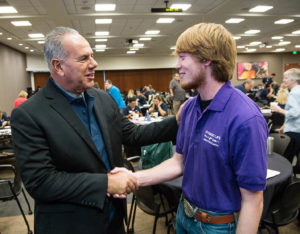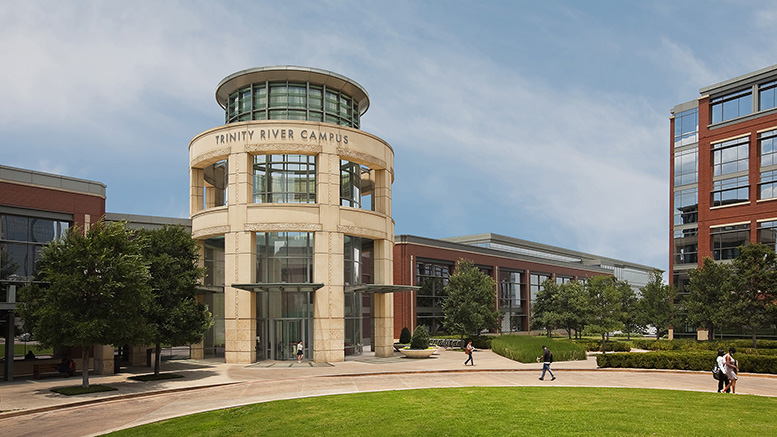Every morning, Mary Brumbach, chief strategy officer at Dallas County Community College District (DCCCD), comes face to face with the region’s economic paradox. On the horizon, construction cranes are silhouetted against the light, evidence of Dallas’ status booming economy.
But on either side of Ross Avenue — a rapidly gentrifying street previously peppered with mom-and-pop shops — she sees the tired faces of people whom she knows work up to five minimum wage jobs just to keep food on the table. Today, 60 percent of county residents live below the poverty level.
Taking in the big picture, she says she thinks, “If we’re not careful, if we don’t get it right, we could be a third-world country in Dallas.”
This excerpt comes from the current issue of AACC’s Community College Journal.
But this disconnect also gives her a goal. She’ll know her work is successful, she says, when she can approach one of those weary faces on the street and tell them, “Come with me; we’ll put you in a program and in six weeks you’ll have a certificate that will translate into a job that pays more than $12 an hour.”
“Then I’ll know that we’ve started to make the turn,” she says.
By “we,” she means the community college district, which is to say, the Dallas County community at large. That switch — from grading the college on internal metrics of enrollment and graduation, to looking at how the district can sustain and nurture the communities in which they’re located — marks a shift in the mission of the district. And it’s already showing results.
A tale of two economies
Tarrant and Dallas counties are side-by-side blocks comprising 1,772 square miles. They are home to the region’s big economic centers, Fort Worth and Dallas, respectively. If you look only at the Texas Federal Reserve Banks’ data on regional economic growth, the picture here is rosy. In November 2017, for instance, jobs grew by 5.2 percent, up from 3.7 percent in October. Driven mostly by the growth in manufacturing and professional and business services, the region’s overall unemployment rate is 3.2 percent, according to data from the Bureau of Labor Statistics. That’s lower than the national rate, which was 4.1 percent the same month.
But if you look below the surface, the story is different. Up until 2014, Dallas had the highest percentage of children living in poverty in the U.S. — 37.8 percent, more than one in three children. In 2016, it’s just the third-worst in the country, tying with Phoenix, at 30.6 percent.

Joe May, chancellor of the Dallas County Community College District
Joe May, DCCCD’s chancellor, says that this means “the students we serve have higher needs than at any time in history.” The drop in poverty level may not be as much about improved conditions for longtime residents. Industry is attracting residents to the area from all over the country, Brumbach says.
“But you can’t import all your labor,” she says. For people who’ve lived in the region for years, it may, in fact, be getting worse. In 1990, Brumbach says, Dallas County’s poverty was concentrated in the majority Black and Latino neighborhoods in the county’s southeastern region.
“By 2010, it had encircled the whole county,” she says. “It was in your face. And that led to the question, ‘What are we going to do?’”
Education as corrective
Education is certainly part of the solution. In Tarrant County, middle-skill jobs requiring some college or an associate degree are abundant. But one out of four working- age adults in Dallas County don’t have a GED or a high school diploma — which means that it’s unlikely they earn more than $20,607.
That’s not enough to live on in a county whose cost of living, marked by the consumer price index, grew by almost the same amount as job growth in November.
Data show that if one in four working-age adults could just get a high school degree, their income would go up to $26,594. And if they had even a little college, their poverty rate would go down by nearly 17 percent and their income would rise to $34,304.
So it was obvious to college leaders in both Tarrant and Dallas counties that they had a powerful role to play in correcting inequities.
But neither DCCCD nor the Tarrant County College District (TCCD) took the traditional approach of simply recruiting more students or forming partnerships with industry. Indeed, for both of them, guided pathways alone wasn’t even enough.
What had to happen, Brumbach says, was that not only did the college’s response to the crisis have to change, but the questions they were asking had to change, too.
Before, we had pretty much focused on questions related to what the colleges were doing,” she says. “Now we’re asking, ‘What does our community need from us?’ It’s an internal-to-external perspective shift and it’s profound.”
Redfining success

Tarrant County College Chancellor Eugene Giovannini greets a student on campus.
Looking at the bigger picture changes what student success means. Is it really success if graduates can’t find jobs in their fields or don’t persist once they get those jobs? asked TCCD Chancellor Eugene Giovannini.
“Here in the U.S., our biggest challenge is creating the 13 million new jobs our growing nation will need this decade,” he says. “Sixty-five percent of children entering primary school today will end up working in completely new job types that don’t exist yet.”
So how do you train for jobs we can’t yet imagine? It takes a short-term and long-term perspective, he says. In the long-term, the district is continuing to work closely with Workforce Solutions for Tarrant County, and to develop an online teaching platform, TCC Connect, to reach students in a way that works for them.
But while that grows, Giovannini and his team are watching Bureau of Labor Statistics forecasts and working with the industries that are here now. In TCCD’s case, that means working with the Dallas-Fort Worth Regional Aerospace Consortium, expanding their computer-numeric machinist and welding programs, and to work with Toyota to bring technician training directly onto campus.
The college is so future facing, that it’s created an e-book for students, of the 42 most affordable and high-value programs at the college.
“In a year or less, students can be on the fast track to a rewarding career,” he says.
But to do it, Giovannini says that the focus can’t just be on potential employers. Indeed, his mandate as a college leader today is not just to work with school districts to make students college ready. The college, he says, “is committed to becoming student-ready,” too.
That means addressing needs that are not typically considered within a college’s purview: This year, in addition to opening a new Workforce Center at its Northwest campus, it is also opening food banks at two campuses, working with the Fort Worth Transportation Authority to start free bus passes for students, and has a Family Empowerment Center, to connect students and community with social service nonprofits.
“Our goal,” he says, “is to provide the services needed to ensure the success of every student that comes to TCC.”

